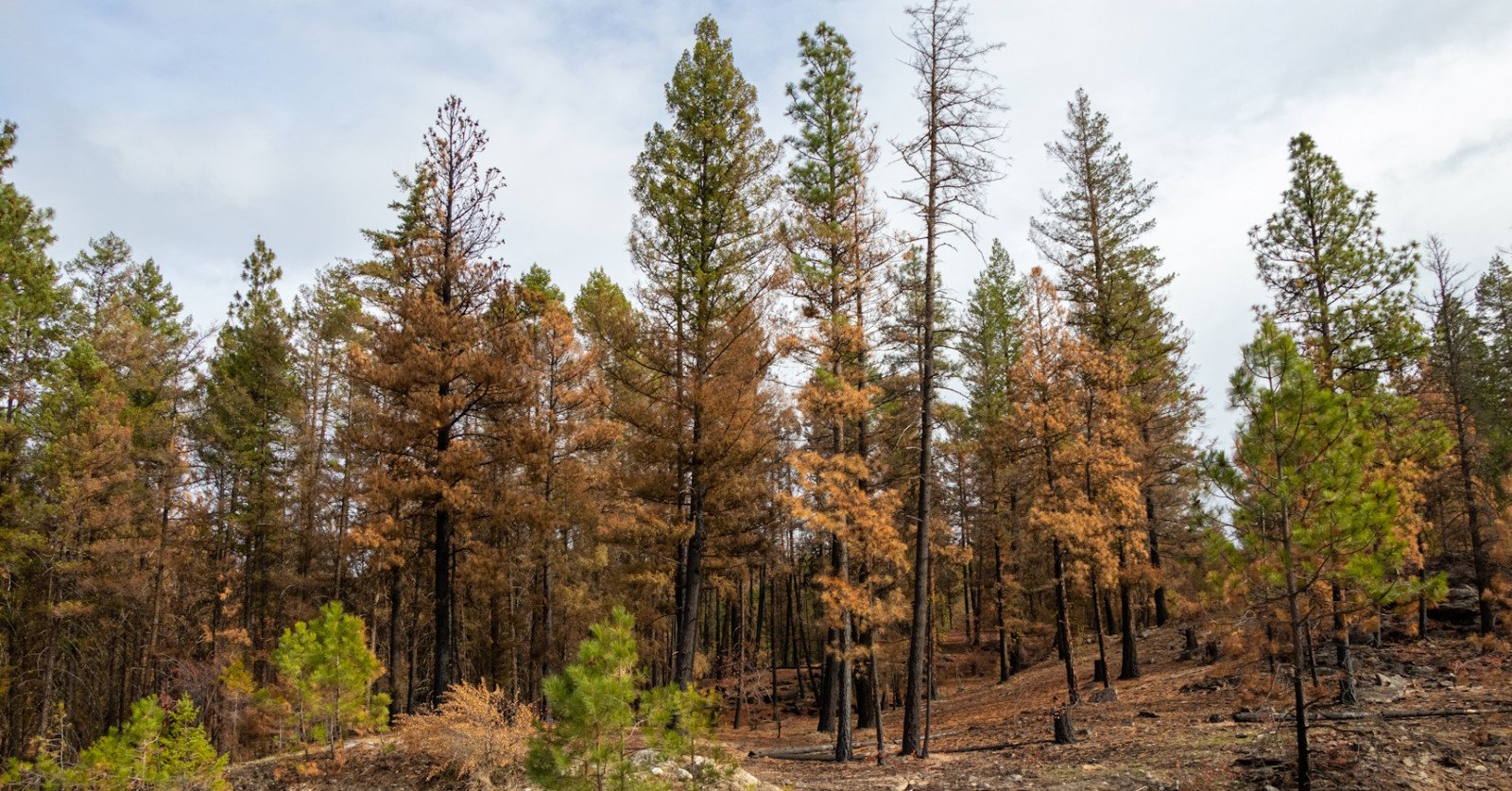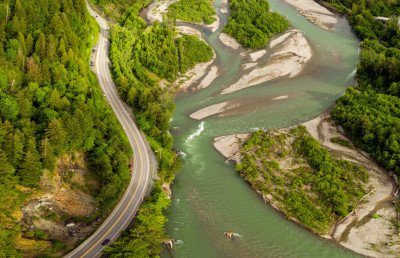Reporting on drought in B.C.
Using critical thinking and group work, students explore historical data on drought in B.C. and its impacts on people and places.

Overview
Explore drought situations in B.C. and the impacts on people and ecosystems. In groups, students will assess the impacts of drought, look at historical data, consider steps that can be taken to deal with drought conditions and create a weather report.
Instructions
What you'll need
- Computer and projector or TV
- Reporting on drought in B.C. slideshow
- Drought in B.C. student handout, one copy per group of 3-4 students
- Access to internet through phones, tablets or computers
- Paper and pens for each group
Introduction
- Start by asking students to define drought and if they think we have drought conditions in B.C.
- Pull up the “Reporting on drought in B.C.” slideshow and at slide 2 share that according to the B.C. Drought Information Portal: “Drought is a long period with below normal rain or snow that may result in a water shortage.”
- At slide 3, share that looking at data collected by the B.C. Provincial Technical Drought Working Group, there has been some drought each year for the past 10 years, with significant drought conditions experienced in seven of those years.
- At slide 4, divide students into groups of 3-4 students and assign each group one of the following identities:
- Animals
- Plants and trees
- Farmers
- People living in nearby cities or communities
- Businesses and industry
- First Nations communities as listed below
- Depending on class size, some groups could be assigned the same identity. Provide each group with paper or notebooks and ask each group to assign a notetaker to record their discussion.
- At slide 5, introduce scenario one: “Drought has lowered groundwater levels” and ask students to critically consider how this would affect their group. As they discuss the impacts have them also rate the impact to their group as major, moderate or minor.
- Provide students about two minutes to discuss each scenario, then ask each group to share their top two conclusions. Some may not find any impacts for some scenarios. Students may share ideas like:
- there is less water moving through the ground to rivers/lakes affecting fish;
- less water for plants to access and wild plants and trees may be stressed or die
- farmers may suffer if they cannot irrigate crops and prices for goods may rise if farmers have less access to water
- people that rely on wells for drinking water or irrigation may have less as wells run dry
- business may be affected that rely on ground water for manufacturing
- stress on native plants and animals may affect Indigenous hunting, fishing, harvesting, cultural practices and livelihoods.
- Continue through five scenarios and have students repeat this process for each.
- At slide 6, introduce scenario two: “Drought has led to water restrictions in communities”. Students may share ideas like:
- general impact of drought on plants, trees and animals could increase disease
- higher mortality and lower reproduction rates
- farmers may have to pay higher rates or even have water restricted or cut off
- people may not be able to use water for lawns and other optional activities
- businesses and industry may have restrictions imposed on water use, leading to higher costs or difficulty conducting their business
- First Nations may or may not have the same water restrictions.
- At slide 7, introduce scenario three: “Drought has reduced river levels, resulting in warmer water temperatures”. Students may share ideas like:
- fish mortality, notably spawning salmon, if river levels are too low or water too warm; stress on plants and animals
- fewer salmon has long-term effects on soil fertility for plants and trees
- farmers who access irrigation water from rivers may be affected; people may not be able to use waterways for recreation or transportation
- businesses and industry relying on waterways may be affected
- First Nations access to traditional foods and areas may be affected.
- At slide 8, introduce scenario four: “Drought has increased the ‘pest’ insect population”. Students may share ideas like:
- spreading of disease among animals, plants and trees
- lower crop yields because of insect damage
- community plants, gardens, parks would be affected
- impacts on forestry and other natural resource industries
- damage to native plants affecting First Nations food and cultural practices.
- At slide 9, introduce scenario five and ask students to consider some other significant impacts of drought that could affect their group. Students may share ideas like:
- forest fires, food supplies, failed businesses and less water available for electricity generation.
- forest fires, food supplies, failed businesses and less water available for electricity generation.
- At slide 10, discuss First People’s knowledge of interconnectedness and sustainability and the definition of watershed from the Indigenous Watersheds Initiative. The Indigenous Watersheds Initiative (IWI) was a three-year initiative (2022-2025) that concluded this year, funding and supporting 49 Indigenous-led projects dedicated to the stewardship and restoration of local watersheds across B.C.
- You can explore the reach of projects through their interactive map.
- There is an 18 minute documentary video that follows five Indigenous communities and organizations as they lead efforts to care for their watersheds
- At slide 11, share that Indigenous teachings tell us that humans are related to the land, the water, the plants and animals. The First People’s Principles of Learning supports the well-being of the self, the land, the community, the spirits and the ancestors, with a focus on connectedness, reciprocal relationships and a sense of place. We must take care and balance our use of water and impacts on the land.
- Ask students to consider where the connections between these teachings intersect with the challenges/solutions of drought. If we are part of the environment and not separate, we can find a way to balance by using less water so every living thing has access to water.
Explore the data
- Provide each group with one copy of the “Drought in B.C.” student handout. Ask students to explore historic drought levels on the Drought Portal and answer the questions outlined.
- Students will need to use a device to do this research. It can be done on phones but will be easier with access to larger screens like a tablet or computer.
Report the weather
- Then assign each group a year from 2015 to present. Include 2015, 2018, and 2023 in the assigned years as they were years of significant drought. Other years can be chosen at random. Students then create and role play a weather report. Criteria for the report are included on the “Drought in B.C.” handout.
- Groups then present their weather report to the class. Students could elect to have the time lapse of that year playing behind them, using a TV or computer and projector.
Modify or extend this activity
- Continue this unit with the next activity: Drought, electricity, and storm safety in B.C.
- Discuss critical news consumption and where to find trusted news sources, with relation to themes like climate change, water shortages and government decision making.
- Explore Indigenous Watersheds Initiative projects, having students do research and create posters highlighting examples of Indigenous led water projects.
Curriculum Fit
Science 9
Big ideas
- The biosphere, geosphere, hydrosphere, and atmosphere are interconnected, as matter cycles and energy flows through them.
Content
- Matter cycles within biotic and abiotic components of ecosystems
- Sustainability of systems
- First People’s knowledge of interconnectedness and sustainability
Curricular Competencies
Questioning and predicting:
- Demonstrate a sustained intellectual curiosity about a scientific topic or problem of personal interest
Processing and analyzing data and information:
- Apply First Peoples perspectives and knowledge, other ways of knowing, and local knowledge as sources of information. Analyze cause-and-effect relationships.
Assessments
- Observe students’ participation in the group activities and responses to the critical thinking questions.
- Assess students’ understanding of drought in B.C. and how it affects all living things. Even if they don't have prior knowledge, encourage them to use their imagination and connect scenarios with their own lives.
- Assess students’ ability to communicate pertinent information in the weather report skit.
- Optional: refer to the rubric evaluation tool created for this unit.
Teaching Notes
Drought in B.C.
Excerpt from the B.C. Drought Information Portal:
“Drought is a long period with below normal rain or snow that may result in a water shortage. Drought, combined with the year-over-year impacts of extreme weather, can affect the water we need for people, fish, animals and the environment.
The Drought Information Portal is a single source to access drought levels across geographic regions in British Columbia. The maps provide information on current and historical provincial drought levels, watershed conditions, and other information related to drought monitoring.”
Impacts of drought
Excerpt from the ClimateReadyBC site: Drought and water scarcity in B.C.:
“British Columbia will experience more drought and water scarcity as the climate continues to warm.
B.C.’s climate is changing. Hotter temperatures, insufficient snow accumulation, faster spring snowmelt, glacier loss, and reduced precipitation over extended periods of time can cause drought and water scarcity. As the climate continues to warm, drought and resulting water scarcity will become more common.
Drought and water scarcity can impact communities in many ways, as they can lead to:
• Reduced water availability for households and businesses
• Warmer river temperatures, affecting fish and aquatic life
• Impacts on groundwater levels
• Reduced crop quality and smaller harvests
• An increase in agricultural pests
Drought situations also increase the risk of wildfire, creating conditions for fires to spread more easily, faster, and burn for longer. It can affect crop production, leading to smaller harvests or lost crops. It can also leave less water available for household and business use, with varying impacts to social, economic and cultural activities.”
The impacts of climate change will continue to influence water levels in B.C. This has had, and will continue to have, impacts on people, ecosystems, food supplies, and industrial activity. As a place that has historically had abundant water, water scarcity can be a difficult concept for B.C. residents to comprehend and act on.
Drought and First nations communities
First Nations communities around the province play important roles in protecting and stewarding the land and water for future generations.
Excerpt from the Indigenous Watersheds Initiative:
“Watersheds hold profound significance for First Nations communities as they are integral to their cultural, spiritual, and physical well-being. These vital ecosystems, encompassing rivers, lakes, wetlands, and surrounding lands, play a pivotal role in sustaining traditional ways of life for many Indigenous peoples. Watersheds serve as sources of nourishment, providing fish, plants, and other resources crucial to traditional diets. Additionally, these environments often hold sacred value, connecting First Nations to their ancestors and spiritual practices. As caretakers of land and water, First Nations recognize the delicate balance within watersheds and the necessity of preserving them for future generations. The well-being of these ecosystems directly influences the overall health and resilience of the community, making the conservation and sustainable management of watersheds not merely an environmental and economic concern but also a fundamental aspect of cultural preservation for First Nations.”







